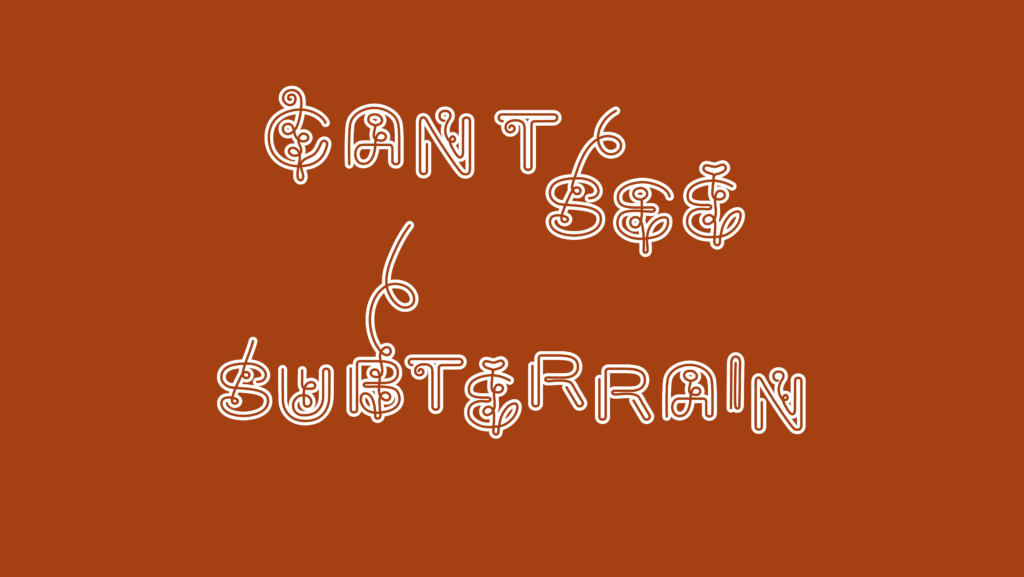This is the subterranean underworld – the layers of terrestrial Earth revealing themselves. It is an environment where the processes of growth start and where they ultimately diffuse. As a mole, we dig ourselves through the pitch black tunnels, smelling the earth, decay and sulphurous compounds. Here is the huge dark Core of the Earth, slowly breathing and moving in its own rhythm; an altar for the underworld, made of clay; a painting born out of silt, gathered from a recent human-led catastrophe. The ground remembers, but it also absorbs, digests and finally loses all traces of what’s ever been.
This exhibition stems from the surrounding darkness. It starts from the feeling that the world is crumbling in our hands, while a strong wind blows the last of its remains even further. We cannot see the ever-growing threat of ecological destruction, just as we cannot see the potential new directions and life forms rising from the ruins of the old world.
Can’t See is divided into four chapters, which will provide a glimpse into spaces and times that are not usually perceived by the human eye: from the depths of the sea and layers beneath the soil to the debris of the past and visions of the future. The stories are told from a range of perspectives, from hybrid birds to bacteria, sea creatures, an ancient tree or the ever blasting wind, aiming to present different ways of seeing and experiencing the world that detach from the numerous perspectives we are accustomed to. The moment in time is not fixed, allowing us to travel deep into the mythical past or imagine futures yet to come.
Aaloe-Ader-Flo-Künnap-Soosalu is a group of Estonian artists, architects and urban planners who are represented at the exhibition with their work O (2011), which was first made for the LIFT11 festival of urban installations. O is a huge black ball and just as the blindfolded player in Blind Man’s Buff feeling their way around in the darkness, at the exhibition, O symbolises the dark unknown that is approaching us as a great force and that cannot be stopped.
Anna Líndal (b. 1957) works and lives in Reykjavik, working with questions such as how colliding human and geological time scales manifest in objects and environments. The artist has taken part in research expeditions to Surtsey. The works presented here were made possible with support and collaboration of scientists that took part in the SUSTAIN drilling project on Surtsey in 2017.
Daiga Grantina (b. 1985) is an artist born in Latvia, who lives and works in Paris. She creates large-scale sculptural assemblages that emulate the natural world, often resembling terrariums and vegetation. Her laboured configurations employ synthetic materials and incorporate conflicting physical qualities: soft and hard, transparent and opaque, mobile and static, strong and weak.
Gerður Helgadóttir (b. 1928, d. 1975) was a pioneer of abstract sculpture in Iceland and created works in iron, bronze, clay, concrete, stained glass and mosaic. She was the first Icelandic artist to study in Florence in 1947 at the sculpture department at Accademia di Belle Arti and afterwards in Paris at Académie de la Grande Chaumière.
Jóhannes Sveinsson Kjarval (b. 1885, d. 1972) was one of the pioneers of Icelandic art in the 20th century and is one of the country’s most beloved artists. His connection to and interpretation of Iceland’s natural environment is thought to have taught Icelanders to appreciate it anew and to have encouraged pride in the country’s uniqueness and the world of adventure to be discovered within it.
Jussi Kivi (b. 1959) is a Finnish artist who lives and works in Helsinki. Over the past two decades, Kivi’s work has revolved around his explorations of wastelands and remote and often neglected underground locations in both Finland and other countries. He mainly uses photographs, drawings and installations.
Kadri Liis Rääk (b. 1990) is an interdisciplinary artist based in Tallinn, whose practice combines methods of scenography and speculative design, putting emphasis on creating immersive, multimodal experiences. Her works play with archetypal and symbolic narratives, touching upon the entanglements and dialogues of different life forms in an ecological melting pot, seething from different strata.
Katya Buchatska (b. 1987) is an artist who lives and works in Kyiv. Buchatska works in various media, such as painting, installation, sculpture, photography and video. Her works address human and non-human relations, the remnants of antiquity, corporeal vulnerabilities to violence, and the possibilities that stem from changing perspectives.
Monika Czyżyk (b. 1989) is a visual artist based in Helsinki. She works primarily with the moving image in the context of experimental documentaries and socially engaged projects. Her ongoing body of work expands upon a form of techno-sublime aesthetics, exploring human and non-human scales, sonic disruptions, impossible landscapes, and ungraspable truths.
Valgerður Briem (b.1914, d. 2002) was an Icelandic artist and teacher. Briem was a highly respected art instructor and a pioneer in her profession, emphasising the necessity of perceptual sensation and urging her students to express themselves fully and emotionally. In her art, she worked mainly with drawing, producing large clusters of ink sketches, working with various themes, which were mostly unknown during her lifetime.
Zenta Logina (b. 1908, d. 1983) was a pioneer of Latvian abstractionism who worked in various genres and directions: painting, textile art, sculpture. Zenta Logina’s artworks have been described as “the gold fund of Latvian non-conformist art.”
